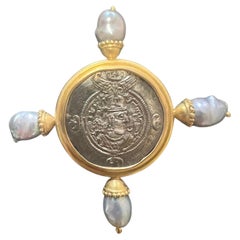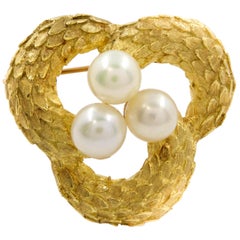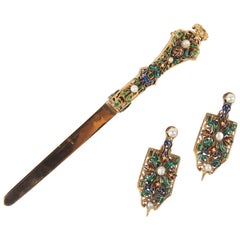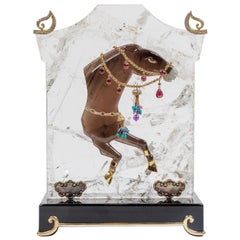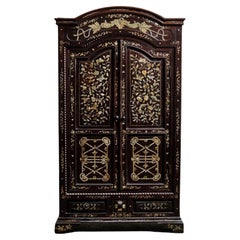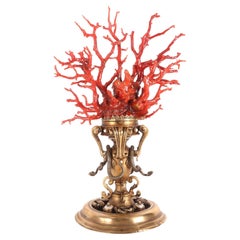Mother-of-Pearl Collectible Jewelry
Color: Gold
Material: Mother-of-Pearl
Large 19th Century Lacquered and Gilded Jewelry Box with Inlaid Mother of Pearl
Located in Nova Scotia, NS
Rare Victorian (c. 1850) lacquered papier-mâché jewelry box with inlaid mother of pearl and gilding depicting a floral motif. The mother of pearl looks of high quality and shimmers w...
Category
1850s Victorian Antique Mother-of-Pearl Collectible Jewelry
Materials
Metal, Gold Leaf
Elizabeth Locke Silver Saanian Roman Coin Sea Pearl 18k Gold Frame Pin or Brooch
Located in Plainview, NY
An exquisite Silver Sasanian Coin Depicting Xusro I ( circa 300AD) with Baroque South Sea Pearls in an 18K Gold Frame Brooch or Pin by the legendary jewelry designer Elizabeth Locke....
Category
20th Century Baroque Mother-of-Pearl Collectible Jewelry
Materials
Gold
Vintage Italian 18K Yellow Gold "Feathered" Three Pearl Brooch
Located in Shippensburg, PA
Vintage Italian 18K Yellow Gold "Feathered" Three Pearl Brooch
Item # 012BAP02M
A striking retro brooch with a feathered texture throughout the three interwoven circles that swirl a...
Category
20th Century Italian Mother-of-Pearl Collectible Jewelry
Materials
Gold
18 Carat Golden Paper Knife with Paperclips, circa 1900
Located in Esbeek, NL
18 carat golden paper knife with paperclips.
Enamel de limoges, pearls and sapphire, circa 1900.
French.
Category
Early 20th Century French Mother-of-Pearl Collectible Jewelry
Materials
Gold, Enamel
Mellerio Paris, A French Gold, Diamonds, Silver, and Smoky Quartz Carved Horse
By Mellerio
Located in New York, NY
Mellerio Paris, A French Gold, Diamonds, Silver-Gilt, Rock-Crystal, Jade, Mother-Of-Pearl and Smoky Quartz, Carved Horse Sculpture, Jeweled Mounted Object.
An extremely rare and unique, one of a kind French gold, diamonds, Silver-gilt, rock-crystal, jade, obsidian, mother-of-pearl, and smoky quartz carved jeweled sculpture "CHEVAUX DE LEGENDE", "A Legendary Horse" by Mellerio, Paris, circa 1991.
Sitting on black obsidian base, the solid rock-crystal slab is finely applied with a carved smoky -quartz and jade horse with a harness mounted in 18k gold, brilliant -cut diamonds, rubies, turquoise, and amethyst chains and pendants. The top columns adorned with 18k gold and brilliant cut diamond pendants, the bottom with gold and mother of pearl plaques. The obsidian base with a plaque engraved: CHEVAUX DE LEGENDE" / N° 05 / MELLERIO DITS MELLER / PARIS / 5003 D
The piece is in excellent condition and comes with a custom made wood case made for transport. It's very elegant and has French hallmarks throughout. A truly magnificent piece.
Measures 10.5" high x 8.5" wide x 4" deep
Founded in France in 1613 by the descendants of Italian immigrants from the Vigezzo Valley in the north of Italy, Mellerio is one of the oldest jewellery houses in Europe. The family business soon attracted the attention of the Royal Court and Marie Antoinette herself reportedly purchased a precious bracelet featuring 7 cameos surrounded by rubies in 1780. Later on, in the 19th century, Mellerio became the official supplier of the French Royal family and the Court of Netherland.
Mellerio creates many jewellery items, all set with rare gems such as peridots, amethysts, aquamarines, citrines and topaz, applying for a patent, the flexible stem, a very supple and light jewellery mechanism. Mellerio remains also well known for their spectacular series of Art Nouveau jewels, created at the beginning of the 20th century, as well as for the creation of trophies rewarding some of the greatest footfall and tennis players of history. In 1993, the jewellery house launched their first watch collection.
Today, Mellerio has stores in Paris, Japan and Hong Kong.
July 14, 1789: this date is known throughout the world as the beginning of the French Revolution. According to a ledger belonging to House of Mellerio, this was also the day that the jeweler sold a golden key to the Comte de Coutance for 10 livres. This ledger, as well as inventories dating as far back as 1768, are the jeweler’s oldest archives. These archives have continued to grow over the years, as the House, established on rue de la Paix in Paris, still lives on today, still in the hands of the same family from Craveggia, in the North of Italy.
The tumultuous history of the Mellerio family in France probably goes as far back as the Italian wars of the Renaissance, but the first official document proving their commercial activity in Paris dates back to 1613. This document is the famous royal warrant awarded by Marie de Medici to a number of Italian families established along the rue des Lombards, including the Mellerios, allowing them to sell “small jewelery items”, therefore granting them a small exception to the traditional monopoly enjoyed by Parisian jewelers. At that time, powerful corporations regulated the operations and customs of Parisian business, but thanks to this exceptional warrant, the Mellerios managed to escape the confines of this framework. Today, this wax-sealed document is kept at the city hall of Craveggia.
From 1613 to the Revolution, the Mellerios lived between France and Italy. The corporations tried many times to put an end to their trade privileges, but all in vain, as a dynasty of sovereigns renewed the warrant. Always marrying and often retiring in Craveggia, the Mellerios continued to maintain their jewelry business in Paris. At first, they did this without a shop. Wearing backpacks (wooden boxes divided into small compartments where jewels were kept), they would tour town fairs around Paris and royal castles.
This is how Jean-Baptiste Mellerio (1765-1850) is said to have sold a bracelet set with rubies and Antique cameos to Marie-Antoinette, which still exists today. Many elements seem to prove the veracity of this anecdote. The queen was particularly fond of cameos, which cover the entire background of her famous jewelry cabinet, and ruby was her favorite stone after diamond. The famous bracelet, reacquired a few years ago by the House of Mellerio, is indeed an 18th century jewel, set with antique cameos representing the profiles of Roman emperors. Two branches of the family were operating in Paris during this time, under the reign of Louis XVI: that of Jean-François (1746-1828), the paternal ancestor of the current Mellerios, and that of Jean-Baptiste (1765-1850).
The French Revolution forced them to return to Italy. However, both Jean-Baptiste and François Mellerio (1772-1843), who was the son of Jean-François, were eventually able to return to Paris after the founding of the Consulate. Jean-Baptiste opened a shop at the Iron Crown of rue Vivienne, and François opened his at the Palais des Tuileries, rue du Coq Saint-Honoré. His well-organized order books give an idea of his high-ranking clientele during the “Old Regime”, among which were the Comte and Comtesse Octave de Segur, the Marquise (later Duchess) de Tourzel, former governess of the royal children, and her daughter, the Comtesse de Bearn, the Craufurds -who organized the flight to Varennes, the Duc and Duchess de Gramont, the Comtesse de Boigne, and Madame de Souza, Talleyrand’s mistress.
We also see the names of the imperial family: Empress Josephine, the Queen of Holland, Princess Elisa, Caroline and Pauline. At that time, the House of Mellerio specialized, among other things, in the trade of antique cameos, a newly fashionable genre of jewel that captured the imagination of all the princesses and noble women of the time.
The years of the Restauration and July Monarchy were among the most glorious. The Bourbons were back on the throne, and the clientele of the House of Mellerio had regained its former wealth. Mellerio supplied Louis-Philippe, Duke of Orléans, as well as his mother, wife and sister, with sumptuous jewels, including a set of emeralds made piece by piece, while the Duke of Bourbon, last prince of the House of Condé, offered diamonds to his mistress, the scheming Baronne de Feucheres, and Monsieur de LaFayette also bought cameos for one of his granddaughters. For the first time, Mellerio ventured into the world of arts in 1815, when Carlotta Grisi, a famous dancer who created Giselle, as well as an actress named Rachel, bought jewels at the Mellerio store on rue de la Paix.
1848 marked a new turning point. France once again became a Republic. François Mellerio handed the company over to his son, Jean, and the latter decided to travel to Spain to build a new clientele. He later became one of the jewelers of the royal family, and met Eugénie de Montijo, who remained a faithful client when she became empress of the French people. The Imperial years were lavish. During the Second Empire, Paris was a pageant of crinoline dresses designed by Worth, while jewels by Mellerio, Worth’s neighbour on the rue de la Paix, adorned the noble women of the Tuileries court.
The Empress bought pearls. Mathilde Bonaparte...
Category
20th Century French Mother-of-Pearl Collectible Jewelry
Materials
Jade, Quartz, Rock Crystal, Gold, Silver
Related Items
Japanese 19th Century Miniature Lacquer Chest with Waterfall
Located in Hudson, NY
Japanese 19th century miniature lacquer chest with waterfall. Late Edo to early Meiji period lacquer chest (mid to late 19th century) with two characters on the front reading Nuno an...
Category
Late 19th Century Japanese Antique Mother-of-Pearl Collectible Jewelry
Materials
Gold, Silver, Bronze
French Colonial Rosewood Armoire with Inlaid Mother of Pearl
Located in Pasadena, CA
French Colonial rosewood armoire with inlaid Mother of Pearl. Two large doors with two drawers near bottom.
Category
20th Century Mother-of-Pearl Collectible Jewelry
Materials
Rosewood
Kuba Currency Spear, circa 1900
Located in Chicago, IL
While shield and spear were central to African combat, this example by the Kuba People of Central Africa was most likely made to serve as a piece of trade currency. Many pre-coloniza...
Category
Early 20th Century Congolese Tribal Mother-of-Pearl Collectible Jewelry
Materials
Iron
19th Century English Olivewood and Brass Inlaid Cabinet
By Town & Emanuel
Located in London, GB
A William IV cabinet attributed to Town and Emmanuel
Constructed in a strongly grained olivewood and dressed with gold brass inlays and an etched and engraved brass panel; rising from a plinth base, the lockable single door having an inset panel in the manner of Jean Berain, enclosing a shelved interior, and flanked by narrow vertical conforming panels; the apron being dressed with three bronze rosettes, and the Jura Jaune marble is dressed with a three quarter arcaded brass gallery,
circa 1830
The cabinet is illustrated and discussed in Christopher Payne’s “British Furniture 1820 to 1920” published in 2023. Payne singles out the rarity of the olivewood timber used as well as the necessity for hand cutting the large marquetry panel.
Literature:
Payne, Christopher. British Furniture 1820 to 1920 : The Luxury Market. ACC Art Books, 2023, pp. 38-39 (illus. fig. 1.33).
Town and Emanuel
Recorded in the 'Dictionary of English Furniture Makers 1660-1840', published by the Furniture History Society, as being situated at 103 New Bond Street between 1830 and 1840, and apart from being manufacturers of furniture, also dealt in 'curiosities and antiques'. The late renowned connoisseur Christopher Gilbert records in his 'Pictorial Dictionary of Marked London Furniture' London 1997, also published by the Furniture History Society, a writing table in the Transitional manner with similar plaques. Their label reads 'Town and Emanuel, manufacturers of Buhl Marquetrie, Resner (sic) & Carved Furniture, tripods, screens & c. of the finest and most superb designs of the Louis 14th. Splendid cabinets and tables inlaid with fine Sevres and Dresden china...
Category
19th Century English Regency Antique Mother-of-Pearl Collectible Jewelry
Materials
Marble, Brass
19th Century Mahogany and Inlaid Display Cabinet
Located in Martlesham, GB
19th century mahogany and inlaid display cabinet, the shaped cornice above an inlaid frieze, two glazed doors below opening to reveal two glass shelves inside, the bottom of each doo...
Category
1890s British Antique Mother-of-Pearl Collectible Jewelry
Materials
Mahogany
Lapis Lazuli Horse Knight
Located in Somis, CA
A beautiful hand carved horse bust in grade AAA natural lapis lazuli. The horse with robust neck and windswept mane, mouth slightly open and large alert eyes. Lapis of beautiful coba...
Category
20th Century Afghan Mother-of-Pearl Collectible Jewelry
Materials
Lapis Lazuli
18th Century Italian Silver and Gold Crucifix with Mica and Calcite Crystal
By Interi
Located in Dublin, Dalkey
18th century Italian silver and gold leaf crucifix adorned with baroque pearls and mounted on a mica cluster and a calcite crystal. The mica specimen is from the Great Smoky Mountain...
Category
18th Century Italian Rococo Antique Mother-of-Pearl Collectible Jewelry
Materials
Rock Crystal, Gold Leaf, Silver Leaf
18th/19th Century French Provincial Religious Oratory Sacristy Cabinet
Located in Forney, TX
A scarce French Provincial Louis XV (1715-1774) / Louis XVI (1774-1792) Period mixed wood religious oratory (prie-dieu / altar)
Hand-crafted in France in the 18th century, with later 19th century elements, likely originating in the south of France / Mediterranean region, featuring pegged solid wooden construction of warm, rich fruitwood, chesnut, oak, and maple.
Having a slant-front bureau with tall raised back decorated with three Renaissance Revival style high relief panels, the center depicting religious scene comprising Jesus and winged Saint, the side panels with foliate floral fruit pendant carvings, flanked by classical turned baluster-form columns, surmounted with highly stylized hand carved and turned finials. Over a slant-front with star parquetry, the hinged drop-front opens to reveal a distressed leather writing desk / lectern / pulpit on which the holy books can be laid open and allows to shelter the books, which were considered precious goods at that time. The lower sacristy cabinet has a pair of slide-out supports flanking a paneled cupboard door decorated with a large stepped base Christian cross parquetry inlay, affixed with later decorative forged iron faux escutcheon overtop. The door opening with key to a single fixed shelf on which holy items...
Category
Late 18th Century French French Provincial Antique Mother-of-Pearl Collectible Jewelry
Materials
Iron
Early 20th c. Wood and Leather Horse Pull Toy c.1930
Located in San Francisco, CA
ABOUT
An early 20th century carved wooden horse pull-toy covered in fabric with glass eyes, leatherette ears, leather saddle and halter, human hair tail and mane mounted on a shaped...
Category
Early 20th Century American Industrial Mother-of-Pearl Collectible Jewelry
Materials
Metal
Asian Mandala Tanka circa 1900
Located in Beuzevillette, FR
Very beautiful tanka mandala of the 19th century painted on canvas . Buddha is in the center with the naga on his right arm, surrounded by others arranged like the rays of the sun. T...
Category
19th Century Asian Antique Mother-of-Pearl Collectible Jewelry
Materials
Canvas
18K Gold Paloma Picasso for Tiffany & Co Zig-Zag Squiggle Pin Brooch
Located in Shippensburg, PA
PALOMA PICASSO FOR TIFFANY & CO ZIG-ZAG SQUIGGLE PIN
Circa 1983, with original Tiffany & Co. drawstring pouch
Item # 010SIU17A
One of the more substantial versions of this iconic design by Paloma Picasso for Tiffany & Co, this version comes in at a hefty 25.3 grams in total weight and is incredibly eye catching with its larger overall profile. The high-polish surface of the front is opposed by a gorgeous matte finish surface to the back, this with a high-polish signature plate towards the end of the squiggle reading "(c) 1983 TIFFANY & CO 18K Paloma Picasso".
Specifications:
*Composition: 18k yellow gold body, 14k yellow gold pin and clasp
*Markings: "1983 Tiffany & Co 18K" and Paloma Picasso signature...
Category
20th Century American Mother-of-Pearl Collectible Jewelry
Materials
Gold
Early 1900s Golden Brown Metal & Tiffany Glass Church Entrance Pendant Light
Located in Lisse, NL
Small church entrance light fixture with a cast iron tassel.
The former owners told us that this rare and all-original light fixture once was on the ceiling at the entrance of a small Gothic Revival...
Category
Early 20th Century European Gothic Revival Mother-of-Pearl Collectible Jewelry
Materials
Brass, Iron
Free Shipping
H 35.8 in Dm 7.1 in
Previously Available Items
Large Coral Branch from Wunderkammer, Trapani, Italy, 1820
Located in Milan, IT
An important Mediterranean red coral tree (Corallium Rubrum).
The base is made of gilded bronze, with a circular foot with a wavy profile that rises to...
Category
Early 19th Century Italian Antique Mother-of-Pearl Collectible Jewelry
Materials
Coral, Silver, Bronze
David Yurman 18k Yellow Gold “Cable” Necklace with 6 Cultured Pearls
By David Yurman
Located in Shippensburg, PA
An exquisite choker necklace by David Yurman in his iconic "Cable" design, the form has become an important signature in his work and is immediately recognizable. This finely crafted...
Category
21st Century and Contemporary American Mother-of-Pearl Collectible Jewelry
Materials
Gold
Luxury Opera Glasses, "La Corona, Paris", circa 1880
By La Corona, Paris
Located in Incline Village, NV
Absolutely exquisite pair of operable mother of pearl high quality luxury opera glasses with fancy handle and gilt metal mounts. Premium mother of pearl and only the most glowing pearlescent shells of abalone or oyster, particularly strong in color, were used in the making of these Victorian binoculars; marked "La Corona...
Category
Late 19th Century French Victorian Antique Mother-of-Pearl Collectible Jewelry
Materials
Gold Plate
18kt Gold Sterling Diamond Malachite Earrings by Asch Grossbardt, 1990s
By Asch Grossbardt
Located in New York, NY
A beautiful pair of vintage designer earrings by Asch Grossbardt, circa 1990s. Earrings are inlaid and comprised of 18-karat gold, sterling s...
Category
1990s American Mother-of-Pearl Collectible Jewelry
Materials
Coral, Lapis Lazuli, Malachite, Onyx, Gold, Sterling Silver
H 0.88 in W 0.88 in D 0.38 in
Van Cleef & Arpels 'Alhambra' Cufflinks in 18-Karat Gold and Mother-of-Pearl
Located in New York, NY
A pair of exquisite quatrefoil cufflinks by Van Cleef & Arpels from the Alhambra collection, in lustrous 18-karat gold, inset with mother-of-pearl. Includes original box, embossed with logo on the front and label printed on lining of box lid. Markings include Van Cleff...
Category
Early 2000s French Mother-of-Pearl Collectible Jewelry
Materials
Gold
H 2.13 in W 3.5 in D 3.5 in
Recently Viewed
View AllMore Ways To Browse
Heuer 2446
Italy Heavy Gold Id Bracelet
Jackets with Fur
King Tut Pendant
Jorge Jensen
Kate Spade Jewelry
Laura Ramsey
Magnus Carlsen
Spratling Cufflinks
John Donald Ring
Lovers Eyes Oval Pin By Mn
Miriam Haskell Blue Green
Geneva Clock Co. On Sale
Elsa Schiaparelli Watch
Destino Cufflinks Vintage
William Spratling Cufflinks
Yellow Gold And Diamond Ladies Wedding Rings
Bogoff Jewelry
